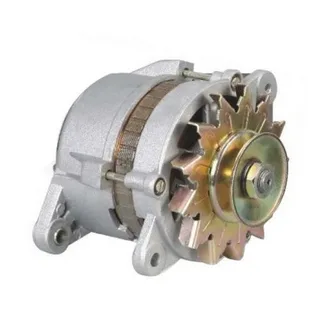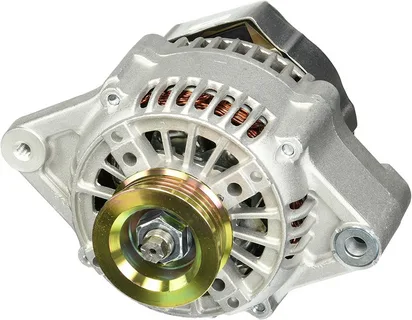When it comes to keeping your Suzuki Carry running smoothly and efficiently, one component that often doesn’t get as much attention but plays a crucial role is the Suzuki Carry alternator. This piece of equipment is essential for charging your vehicle’s battery and powering the electrical systems while the engine is running. Understanding how to maintain and enhance the performance of your Carry alternator can save you from unexpected breakdowns and ensure your vehicle operates at its best.
Understanding the Role of the G13BB Alternator
The G13BB alternator is a vital component in the Suzuki Carry’s electrical system, specifically engineered to cater to the demands of vehicles equipped with the G13BB engine. This alternator plays a pivotal role in converting the mechanical energy produced by the engine into electrical energy, which is then used to charge the vehicle’s battery and power various electrical systems and accessories while the engine is running. The efficiency and reliability of the alternator directly influence the performance and electrical stability of the Suzuki Carry, especially under high-load conditions where the electrical demand is greater.
Unlike generic alternators, the alternator is designed with the specific electrical output and mechanical fittings compatible with the G13BB engine, ensuring seamless integration and optimal performance. It efficiently manages the balance between charging the battery and supplying power to electrical components such as headlights, the audio system, and air conditioning, which are crucial for both the vehicle’s functionality and the comfort of its occupants.
The health of the alternator is paramount. A failing alternator can lead to a variety of issues, from dim lights and weak accessory performance to complete vehicle power failure. Given its central role in the vehicle’s electrical system, understanding the operational status and maintenance needs of the alternator can prevent unexpected breakdowns and extend the lifespan of the Suzuki Carry’s electrical components.
 Common Signs of Suzuki Alto Alternator Issues
Common Signs of Suzuki Alto Alternator Issues
Identifying issues with your Suzuki Alto Alternator early can prevent a minor problem from escalating into a major inconvenience. There are several telltale signs that your alternator may be failing. One of the most common indicators is the illumination of the battery warning light on your dashboard or dimming headlights, which may suggest that the alternator is not providing sufficient power to charge the battery effectively. Another sign to watch for is electrical accessories that operate slower than usual, such as power windows or the stereo system, indicating a drop in the electrical supply.
Strange noises can also be a clue to alternator troubles. A failing alternator can produce a whining or grinding noise caused by worn-out bearings. Additionally, experiencing difficulty starting the vehicle or frequent battery drain, even after a recent charge, can signal that the alternator is not effectively charging the battery. Lastly, a malfunctioning alternator can lead to an unusual smell, such as burnt rubber or hot wires, as the alternator overworks itself or experiences a failure in its wiring or other components.
Paying attention to these signs and taking prompt action can save you from unexpected vehicle downtime and potentially costly repairs. Early diagnosis and intervention are key to ensuring the health of your Suzuki Carry’s electrical system and maintaining its overall performance.
How Much is the suzuki alto alternator price?
Determining the suzuki alto alternator price can vary significantly depending on several factors including the model year, the alternator’s brand, and where you choose to purchase it. Typically, the price range for a new alternator for the Suzuki Alto can fall anywhere between $150 to $500. This broad range is influenced by whether you opt for an OEM (Original Equipment Manufacturer) part, which tends to be on the higher end of the spectrum, or an aftermarket part, which can be more cost-effective.
It’s also important to consider the warranty offered with the alternator, as this can add value to your purchase. Some manufacturers provide a more extended warranty period, which could justify a higher upfront cost by offering peace of mind and potentially saving you from future expenses.
Additionally, if you’re considering having a professional install the alternator, labor costs will need to be factored into your budget. Labor rates can vary widely depending on your location and the service provider. Typically, you can expect to pay anywhere from $50 to $120 per hour for labor, with the total installation time ranging from one to three hours.
To get the best deal, it’s advisable to shop around and compare prices from different suppliers. Also, don’t shy away from asking for recommendations from trusted mechanics or friends who own a Suzuki Alto. They might be able to steer you towards a reliable source or offer advice on choosing the right alternator for your needs. Remember, investing in a quality alternator now can save you from more significant expenses and inconvenience down the line.
How to Diagnose Suzuki Alternator Problems?
Diagnosing issues with your Suzuki alternator doesn’t require specialized tools or extensive mechanical knowledge, but rather a systematic approach to pinpoint potential problems. Begin your assessment by visually inspecting the alternator belt for signs of wear, such as cracks, fraying, or slackness, as a compromised belt can affect the alternator’s performance.
Subsequent to the visual check, start the engine and let it idle. Using a voltmeter, measure the voltage across the battery terminals. In a healthy system, the voltage should read between 13.8 and 14.2 volts. Readings outside this range could indicate a malfunctioning alternator or an issue with the battery itself.
To further evaluate the alternator’s condition, listen for any unusual sounds coming from the alternator area with the engine running. A failing alternator may emit a whining, grinding, or rattling noise due to bearing wear or a damaged pulley. These auditory clues can be key indicators of an alternator that may require service or replacement.
Another useful diagnostic step involves checking the electrical output under load. With the engine running, turn on several electrical accessories, such as the headlights, air conditioning, and the stereo system. Observe the voltmeter’s reading; a significant drop in voltage under these conditions could suggest that the alternator struggles to meet the vehicle’s power demands. By following these diagnostic steps, you can effectively assess the health of your Carry alternator and take appropriate action to address any identified issues, ensuring your vehicle’s electrical system remains robust and reliable.
Maximizing Your Suzuki Alternator’s Lifespan
Maintaining the longevity of your Carry alternator involves a series of preventative measures aimed at minimizing wear and preventing damage. One of the most crucial steps is ensuring that the alternator belt remains in optimal condition. A belt that is too tight can put excessive strain on the alternator’s bearings, leading to premature wear, while a belt that’s too loose might not allow the alternator to charge the battery efficiently. Regular inspections for signs of wear, such as cracks or fraying, can help you determine when a replacement is necessary.
Water exposure is another critical factor to consider. Although the Suzuki Carry is built to handle various driving conditions, deep water crossings pose a significant risk to the alternator. Water can cause corrosion of its internal components or lead to electrical shorts. Whenever possible, avoid driving through deep water or, if unavoidable, take measures to protect the alternator from direct exposure.
In addition to these steps, maintaining the overall health of your vehicle’s electrical system plays a significant role in extending the life of the alternator. Address any electrical issues promptly, as faults in the system can cause the alternator to work harder than it should, potentially leading to overheating and failure. By keeping the electrical load within the alternator’s capacity, you ensure that it operates within its designed parameters, thereby extending its service life.
By adhering to these maintenance practices, you can significantly reduce the risk of alternator failure, ensuring that your Suzuki Carry remains reliable and ready to meet your daily transportation needs.
Upgrading Your Suzuki Alternator for Enhanced Performance
For Suzuki Carry owners looking to boost their vehicle’s electrical performance, especially those who have customized their ride with power-intensive accessories, considering an alternator upgrade is a smart move. A higher-output alternator goes beyond the stock capabilities, providing the extra power necessary to support enhanced lighting, sophisticated audio systems, winches, or additional charging ports without compromising the battery’s charge.
Before diving into an upgrade, it’s crucial to assess your Suzuki Carry’s current electrical demands. Calculate the power usage of your added accessories to determine the required alternator output. This foresight ensures you select an alternator that matches your vehicle’s needs without overburdening its electrical system.
When shopping for an upgraded alternator, compatibility is key. Look for units specifically designed for the Suzuki Carry or those that can be adapted without extensive modifications. Opting for a model that aligns with your vehicle’s specifications simplifies installation and integrates more seamlessly with your existing setup.
Additionally, consider the quality and reputation of the manufacturer. A high-quality alternator from a reputable brand might come with a higher price tag but typically offers better performance and longer durability. It’s also wise to check the warranty terms, as a longer warranty period can provide added assurance and value in the long run.
Upgrading your alternator is not merely about meeting the current electrical demands but also about future-proofing your vehicle’s electrical system. With a higher-output alternator, you’re setting the stage for further customizations and ensuring that your Suzuki Carry remains capable and versatile, ready to accommodate whatever innovations or accessories you might decide to add down the line.
FAQS
Q: How often should I check my Carry alternator?
A: It’s advisable to inspect your alternator at least once a year or every 12,000 miles, whichever comes first. Regular checks will help identify wear or potential issues early, allowing for timely maintenance or replacement.
Q: Can I install a higher-output alternator myself?
A: While it’s possible for those with mechanical knowledge and the right tools to install an upgraded alternator, it’s recommended to have a professional perform the installation. This ensures the alternator is correctly fitted and functioning optimally with your vehicle’s electrical system.
Q: What is the average lifespan of a Carry alternator?
A: The lifespan can vary depending on usage and maintenance but typically ranges from 7 to 10 years. Regular maintenance and addressing any electrical system issues promptly can extend this lifespan.
Q: How do I know if an alternator is compatible with my Suzuki Carry?
A: Check the alternator’s specifications against those of your vehicle’s manufacturer. For an upgraded alternator, ensure the output matches your vehicle’s electrical demand. Consulting with a professional or the alternator manufacturer can also help determine compatibility.
Conclusion
The alternator in your Suzuki Carry plays a pivotal role in your vehicle’s electrical system, ensuring a steady supply of power to both the battery and various electronic components. By being vigilant about the signs of potential alternator issues, employing timely diagnostic practices, and adhering to rigorous maintenance routines, you can significantly bolster the efficiency and longevity of your Suzuki Carry’s alternator. Moreover, considering an upgrade can be a wise decision for those who have enhanced their vehicle with additional electronic accessories, ensuring that the electrical system can handle increased demands without faltering.
| Other Good Articles to Read |
| Blogs-Nation |
| Blogs-Peoples |
| Bryan Smith Blogs |
| Intellect Blogs |
| The Fault In Our Blogs |
| Blogs Eu |
| Oz Forums |
| Recruitment Blogs |
| Zet Blogs |
| Id Blogs |
| Blogs Tudiolegale |
| Blogs Map |
| Related Business Listings |
| Contact Directory |
| Local Business Profiles |



